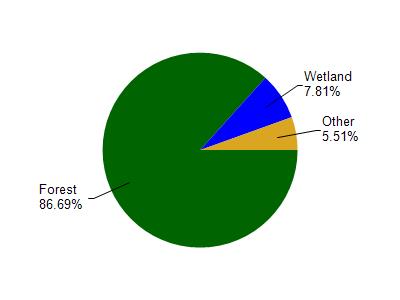
2 Miles
0 - 2
Macroinvertebrate, Coldwater
Unknown
Bayfield
No
No
No
Fish and Aquatic Life
Overview
This small spring-fed stream empties into Squaw Bay on Lake Superior. From the mouth of Saxine Creek to the east is the Apostle Islands National Lakeshore. This stream is considered an exceptional resource water for its Class I brook and rainbow trout fishery. It also supports migratory runs of fish from Lake Superior. This is primarily a nursery for rainbow trout, with the young living in the stream for two years before migrating to the lake to mature, then return to spawn. The stream bottom is mostly sand, with occasional gravel areas used for spawning. Vegetation is primarily upland hardwood. The mouth of this stream is considered important Lake Superior habitat for coastal wetlands.
Wisconsin Trout Streams identifies a Class III trout stream as entering Saxine Creek in Section 30. This is inaccurate. A Class III brook and rainbow trout stream flows from Section 31, through 30, and enters Saxine Creek in Section 19. This stream is a high-gradient spring creek with a number of feeders. Trout habitat is poor due to the shifting-sand bottom and limited food sources. The stream flows primarily through upland hardwoods.
During survey work conducted as part of the coastal wetlands evaluation, four rare species of macroinvertebrates were found in Saxine Creek and overall taxa richness was moderate (5-24 species) (Epstein 1997). The survey noted potential problems due to low flows.
Date 2010
Author Aquatic Biologist
Condition
Wisconsin has over 84,000 miles of streams, 15,000 lakes and milllions of acres of wetlands. Assessing the condition of this vast amount of water is challenging. The state's water monitoring program uses a media-based, cross-program approach to analyze water condition. An updated monitoring strategy (2015-2020) is now available. Compliance with Clean Water Act fishable, swimmable standards are located in the Executive Summary of Water Condition in 2018. See also the 'monitoring and projects' tab.
Reports
Management Goals
Wisconsin's Water Quality Standards provide qualitative and quantitative goals for waters that are protective of Fishable, Swimmable conditions [Learn more]. Waters that do not meet water quality standards are considered impaired and restoration actions are planned and carried out until the water is once again fishable and swimmable
Management goals can include creation or implementation of a Total Maximum Daily Load analysis, a Nine Key Element Plan, or other restoration work, education and outreach and more. If specific recommendations exist for this water, they will be displayed below online.
Monitoring
Monitoring the condition of a river, stream, or lake includes gathering physical, chemical, biological, and habitat data. Comprehensive studies often gather all these parameters in great detail, while lighter assessment events will involve sampling physical, chemical and biological data such as macroinvertebrates. Aquatic macroinvertebrates and fish communities integrate watershed or catchment condition, providing great insight into overall ecosystem health. Chemical and habitat parameters tell researchers more about human induced problems including contaminated runoff, point source dischargers, or habitat issues that foster or limit the potential of aquatic communities to thrive in a given area. Wisconsin's Water Monitoring Strategy was recenty updated.
Grants and Management Projects
| Project Name (Click for Details) | Year Started |
|---|
|
|
Monitoring Projects
| WBIC | Official Waterbody Name | Station ID | Station Name | Earliest Fieldwork Date | Latest Fieldwork Date | View Station | View Data |
|---|
| 2882900 | Unnamed | 10047352 | Unnamed Creek 19-11 - U/S from confluence w/ Saxine Creek | | | Map | Data |
|

Watershed Characteristics
Unnamed is located in the Bayfield Peninsula Northwest watershed which is 236.05 mi². Land use in the watershed is primarily forest (86.60%), wetland (7.80%) and a mix of grassland (4.60%) and other uses (0.90%). This watershed has 473.06 stream miles, 43,216.55 lake acres and 6,677.27 wetland acres.
Nonpoint Source Characteristics
This watershed is ranked Not Ranked for runoff impacts on streams, Not Available for runoff impacts on lakes and Low for runoff impacts on groundwater and therefore has an overall rank of Low. This value can be used in ranking the watershed or individual waterbodies for grant funding under state and county programs.However, all waters are affected by diffuse pollutant sources regardless of initial water quality. Applications for specific runoff projects under state or county grant programs may be pursued. For more information, go to surface water program grants.
Unnamed Trib. Saxine Creek T51n R5w S19 is considered a Macroinvertebrate, Coldwater under the state's Natural Community Determinations.
Natural communities (stream and lake natural communities) represent model results and DNR staff valiation processes that confirm or update predicted conditions based on flow and temperature modeling from historic and current landscape features and related variables. Predicated flow and temperatures for waters are associated predicated fish assemblages (communities). Biologists evaluate the model results against current survey data to determine if the modeled results are corect and whether biological indicators show water quaity degradation. This analysis is a core component of the state's resource management framework. Wisconsin's Riverine Natural Communities.